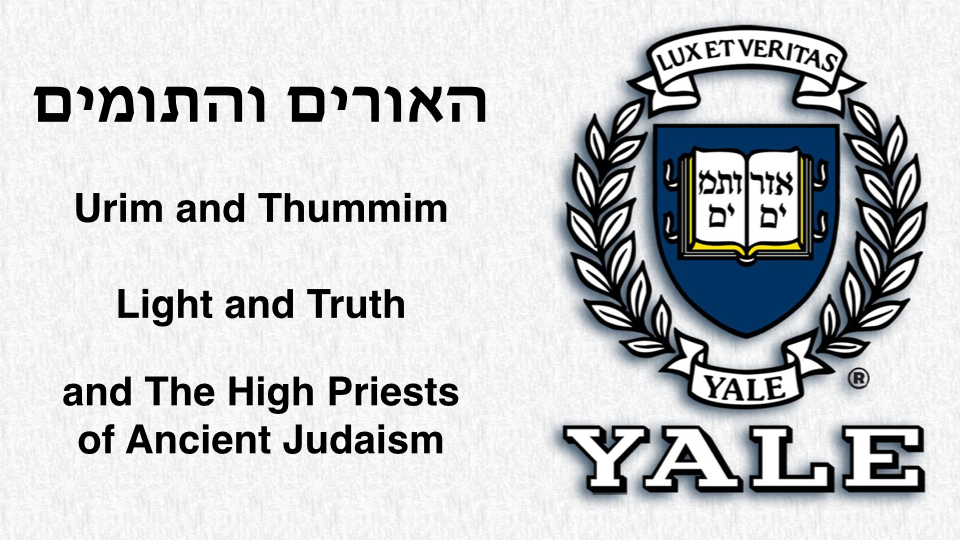Urim and Thummim
The Yale University Shield (shown above) bears an abbreviated Hebrew phrase haʾUrim vəhaTummim (האורים והתומים).
This is the official statement found on Yale’s website regarding these Hebrew words:
The iconography of the Yale shield (or “arms”) is taken from the University’s seal, which was adopted by the Trustees of Yale College in the early eighteenth century. The unknown designer of the seal identified the book as the Bible by words which read “Urim and Thummin,” probably names of sacred lots to be cast for the purpose of ascertaining the divine will.
When the Old Testament of the Bible was translated into Greek, the original meaning in Hebrew of “Urim and Thummin” was no longer known, and different words were used in different passages to translate them. Among the renderings given were “Light” and “Truth,” and it is this interpretation which was chosen for the seal’s legend and placed below the shield in Latin: Lux et Veritas.
The preceding text is adapted from The Arms of Yale University and its Colleges at New Haven, Yale University Press, 1963
There is no further explanation given regarding the decision to choose these Hebrew words.
NOTE: As of December 2023, the statement on Yale’s website, linked above, has been removed from the University’s website.
Meaning Unknown?
This statement seems flawed:
“When the Old Testament of the Bible was translated into Greek, the original meaning in Hebrew of ‘Urim and Thummin’ was no longer known.”
Why would an establishment of higher education make such a statement, and indeed about the very words used in their own institution’s identity and logo?
Is Yale University going on record as stating that the words used in their logo have an unknown meaning and that there is no official record explaining why these words were chosen?
There are present-day copies of Jewish Bibles written in Hebrew that contain these same words untranslated. There are people today who speak Hebrew who can interpret their meaning. We’re not talking about an ancient dead language.
Even when translated from Hebrew to English (or from Greek to English), the words Urim and Thummin can be partially understood by their context.
Indeed, there is a lengthy explanation of their meaning found on Wikipedia as well as other sources.
Higher Education as Modern Urim and Thummim
For purposes of discerning the meaning of Yale’s iconic shield, the mystical and holy context surrounding these items is perhaps as important as the items themselves. We may not know specifically what the Urim and Thummin looked like or specifically how they were used, but we do know that the holy priests of ancient Judaism used them to discern the will of the Almighty. Any reference to the Urim and Thummin cannot be separated from this mystical and powerful context.
Invoking the imagery of the Urim and Thummin for a university that trains up leaders (like present-day priests and judges) is to suggest that the academic achievements and the attainment of knowledge has become a modern-day substitute for (or equivalent to) the ancient tools used for divination.
Perhaps that’s true. Perhaps it’s not. It would take great wisdom or divination to know the answer.
UPDATE: 10 Nov 2023
This document was originally posted on 19 Nov 2013. In the fall of 2023, ten years later, there seems to be a renewed interest in this topic based on page visitor stats. A summary of this document would be to conclude that institutions of higher education have replaced divination, superstition, reading tea leaves, or emotionally influenced religious revelations. Rational scientific data-driven fact-based study has cleared the windshield of societal vision and understanding. We are moving forward with understanding that can be conveyed from one generation to the next.
Page Visit Map
The maps below show recent page visits based on location. Note that place names and boundaries are provided by Open Map Tiles.





